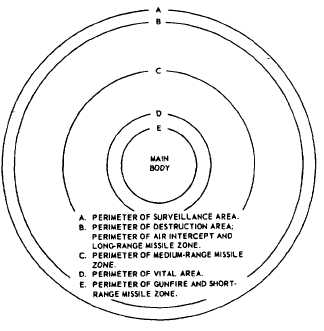| |
Active AAW includes the use of aircraft, anti-
aircraft guns, missiles, and electronic counter-
measures.
(Electronic countermeasures are
employed to jam radars, mask or monitor
electronic transmissions, confuse guidance
systems, present false targets, and the like.)
Passive AAW—measures other than active, taken
to minimize the effects of hostile air action—
involves elements such as cover, concealment, and
dispersion.
Ships and aircraft are joined in a task forma-
tion to accomplish a mission that has been
dictated by strategic necessity. An AAW forma-
tion is designed to protect a carrier, which is the
offensive striking unit of a carrier task force or
battle group.
As enemy aircraft approach in a strike against
our ships at sea, our forces may divide defensive
AAW operations into three phases occurring
successively. The first phase involves the use of
personnel and equipment to search for, find,
evaluate, and report the enemy attack force. The
second phase involves initial active AAW defense
measures—taken while attacking aircraft are at
a considerable distance from the force. These
measures may include electronic deception; air-
craft interception; and long-range, surface-to-air,
guided-missile fire. The third phase, close-range
defense, takes place when attacking aircraft have
penetrated near or within gun range of the main
body of ships being defended. Close-range defense
measures consist of gunfire, short-range missiles,
and evasive maneuvering.
Speeds of modern aircraft and missiles require
that defensive measures be taken as early as
possible at the greatest practicable distance from
the attacking force. An AAW operation, there-
fore, uses distant early warning aircraft, such as
the E-2, and surface picket ships, such as guided-
missile destroyers. Depending on the size of the
formation and nature of the threat, several
sector antiair warfare coordinators (SAAWCs)
may conduct operations in designated areas.
SAAWCs report to the force antiair warfare
coordinator (FAAWC) who then coordinates
defenses over the entire task force area of
responsibility.
The FAAWC normally determines the extent
of the antiair warfare area, which encompasses
the total region to be protected from enemy air
attack. Figure 12-3 maps the subdivisions of the
AAW area. Concentric circles surround the main
body of ships at distances determined by the
nature of the expected attack. The circles
represent the outer perimeters of the subdivisions.
The surveillance area, the outer limit of which
Figure 12-3 .-The force antiair warfare coordinator
(FAAWC) determines the extent of the AAW area.
corresponds to the perimeter of the entire AAW
area, is the region of search, detection, and
tracking. The destruction area is the sector (within
the surveillance area) in which destruction or
defeat of the enemy airborne threat should
occur. It is divided into an air-intercept and long-
range missile zone, medium-range missile zone,
and gunfire/short-range missile zone. The vital
area contains the main force of ships that must
be defended.
The AAW area usually is oriented about an
AAW axis, or threat axis. The AAW axis is a true
bearing from the vital area to the most probable
direction of enemy attack. Early warning aircraft
and ships normally are deployed along the AAW
axis. A number of factors affect the choice of an
AAW disposition. These include the submarine
threat, available ships and aircraft, fuel, amount
of protection required, and weather. Whenever
possible, mutual support from nearby units is
obtained through the overlapping of AAW areas.
Although conventional gunfire can be effective
in AAW, high-speed jet aircraft have made
defense by gunfire a last-ditch effort. At 600 miles
per hour, an attacking aircraft is within effective
range of a 5-inch gun for less than a minute before
the plane reaches its drop point. This speed allows,
at best, about 100 rounds of gunfire from one
ship. In World War II we expended an average
of 3,000 rounds of all types to down each
propeller-driven aircraft.
12-11
|

